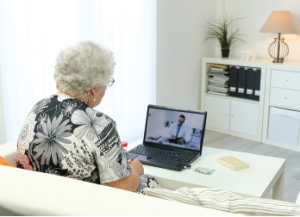
JP WALLET / shutterstock.com
ATLANTA—With growing demand for access to rheumatologists in rural areas, a shortage in the number of rheumatologists and the ability to use technology as a bridge to patients in remote areas, telemedicine seems like a smart option.
And it certainly can be, experts said at a 2019 ACR/ARP Annual Meeting session in November. But a plunge into telehealth takes full commitment, proper training and staying attuned to patient needs and input, they stressed.
The University of Pittsburgh has five telehealth locations in remote spots in western and central Pennsylvania. Christine Peoples, MD, clinical assistant professor of medicine and director of the University of Pittsburgh Medical Center (UPMC) Rheumatology Telemedicine Program, calls telemedicine “my passion for six years.” From January 2016 to December 2018, the center conducted 1,533 telemedicine rheumatology visits involving 535 unique patients and 442 of those new visits. The telemedicine volume has been increasing month after month, she indicated.
For an appointment, patients or providers can contact the main scheduling office, the local teleconsult office in their area or the office where Dr. Peoples works.
“It’s pretty easy to contact us about getting scheduled,” she said. Patients are told it’s a telemedicine visit and not an in-person visit and that they should check with their insurance plan about coverage. Then the local telehealth center calls to confirm with the patient that it will be a tele-visit and to explain what the visit will involve. The program’s website includes information about what to expect.
Outreach to Local Providers
Dr. Peoples has made it a point to reach out to local providers so they know the telehealth program exists.
“That’s really been successful because I can develop relationships with local physicians and providers outside our UPMC system,” she said.
Another important element, she said, is taking patient satisfaction feedback to heart.
“This is something we really home in on, on a regular basis,” she said. “We really take that seriously to try to make changes.”
All in all, patients seem exceedingly happy with the service—across all the centers. When asked how satisfied they were with the visit, patients gave perfect or nearly perfect scores on average.
Dr. Peoples underscored the importance of the physical exam in the visits, which are done by nurses at the local site. “I personally trained the tele-presenting nurses at all these locations,” she said.
Having a good “computer-side manner” is also vital, Dr. Peoples stated. During telehealth visits, from her distance, she explains to patients how the cameras are used, ensures the images are kept private and explains the mechanics of the visit, such as telling the patient when, from her remote location, she is seeing a zoomed-in shot of their wrist on her screen. And she tries to speak “face to face,” granted by way of screens.
A plunge into telehealth takes full commitment, proper training & staying attuned to patient needs
& input.
She cautioned that although coverage for telehealth is expanding, a lot of variation across states exists. “All of us really need to become familiar with our own state’s policies and coverage schemes.”
Work Closely with Administrators
Daniel Albert, MD, a rheumatologist at Dartmouth-Hitchcock Medical Center, New Hampshire, and professor of medicine at Dartmouth School of Medicine, said that—despite all the obvious advantages when done well—the decision to jump into telemedicine shouldn’t be made lightly.
“If you’re going to do this, you have to be very pragmatic about it. It’s not something that you can start on a whim,” he said. “My basic message to you is that it may be anathema to you to deal with your administrators, but you’re going to have to—and you’re going to have to deal with them right from the start before you ever even think about getting this up and running.”
Concerning U.S. Medicare reimbursements, the relative value units generated by telehealth visits are identical to those generated by in-person visits, “so why shouldn’t you do all these visits, as much as you can, by telemedicine? It’s not so easy,” Dr. Albert cautioned.
If your hospital is in a different state from where the patients are—the physician has to be licensed in that other state. If the telehealth site is a hospital, the physician must be fully credentialed at that hospital. This means physicians venturing into telehealth must work closely with administration, he stressed.
“This is not a trivial procedure,” Dr. Albert said.
Variations in State Rules
 Knowledge of individual state laws is essential—in some states, for instance, prescribing by telehealth is acceptable; in others, it’s not. And no state is comfortable with the prescribing of controlled substances via telemedicine because of the potential for abuse. The rules vary.
Knowledge of individual state laws is essential—in some states, for instance, prescribing by telehealth is acceptable; in others, it’s not. And no state is comfortable with the prescribing of controlled substances via telemedicine because of the potential for abuse. The rules vary.
Dr. Albert also cautioned that records and documentation can be more of a burden with telehealth—records are coming from several sources rather than just one electronic medical record at one center.
And, before telehealth can begin, the contracts between the institutions are not a simple matter, either.
“These take a long time to hammer out,” Dr. Albert said. “I would say that if you start today, you’re probably looking at six months to get this thing rolling—and that would be good.”
Despite all of these cautionary messages, telemedicine can be a huge benefit to patients and medical centers, he said.
“People are very appreciative at the ability to speak with a consultant without a really arduous journey,” Dr. Albert said. “Some people can’t do four hours in a car. They’re in too much pain.” A telehealth option could mean the difference between seeing a doctor and not seeing one, he said.
“Is it as good as an in-person [visit]? I don’t think so,” he said. “But it’s good—and it’s certainly better than a telephone meeting, especially if you have a good consulting nurse.”
Some centers, Dr. Albert said, shy away from seeing new patients via telemedicine, but many new patients don’t need to be seen in person.
“My attitude toward it is, if I’m confused, I ask them to come down,” he said. “I’m not sure that we need to make that very arbitrary decision that all ‘news’ have to be seen in person. I don’t think that is necessary.”
Thomas R. Collins is a freelance writer living in South Florida.



